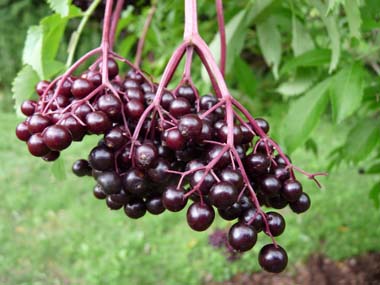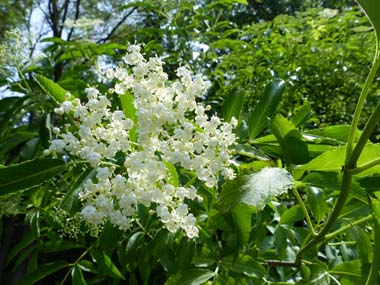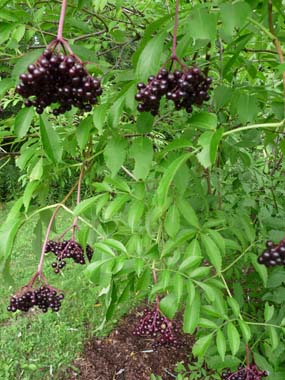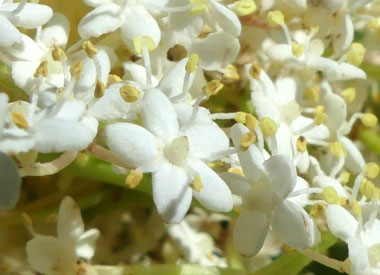







To support our efforts please browse our store (books with medicinal info, etc.).
Sometimes propagated as an ornamental shrub, the elderberry bush is a member of the honeysuckle family. It attracts birds and butterflies and can be pruned back every few years to keep it looking good in a landscaped garden. This deciduous shrub produces a fruit that, in recent years has become very popular. The white flowers transform into dark purple fruit late summer. Although the flowers and berries are edible all other parts of this bush are poisonous containing toxic calcium oxalate crystals. Sambucus canadensis is a very close cousin of Sambucus nigra (European Elderberry).
Trunk/Bark
Elder is characterised by its short trunk (bole). This deciduous shrub has soft, smooth, gray-brownish bark with corky bumps and furrowed bark. Older bark is brownish gray with shallow fissures, becoming rough with thin, plate-like scales.
Branches/Twigs
Twigs are hairless, yellowish green with a white pith and scattered, large lenticels (pores). There is spongy, white pith inside the twigs and branches. Some bushes can be as almost wide as they are tall.
Height
Up to 3 metres.
Leaves/Needles
The leaves are pinnate with 5 to 9 leaflets (rarely 3 or 11). Each leaf is 5 to 30 cm long, and the dark green leaflets have serrated margins.
Flowers
Each radially symmetrical flower has 5 flattened, white petals in a large umbrella-shaped cluster and has five protruding stamens (male parts). The overall flower head measures anywhere between 15 and 30 cm in diametre.
Fruit
Edible purplish-black fruit ripens in drooping clusters late summer and they measure 3–5 mm in diameter. Elderberries are particularly rich in flavonoids, especially anthocyanins. In addition to their culinary uses, elderberries are commonly used in cough syrups.
Habitat
Elderberry prefers moist soil but tolerates dry soil as well. It grows best in full sun. It is native to a large area of North America, east of the Rocky Mountains. They grow wild in parts of Mexico and Central America.
Edible Parts
The berries and flowers are edible. Flowers can be tossed into a salad. Eating the berries raw is not favoured by many. Elderberries tend to end up as pies, in pancakes, jams, jellies, and in wine making.
Other Name
Common Elderberry.
Recipes
Comfrey, Heal-All, Elderflower Salve, Peach Jam, Aronia Macaroons, Elderberry Cold and Cough Syrup, Elderberry Freezies, Ginger Soda, Ginger Syrup, Meringue Pie, Elderberry Pie, Elderberry Raison Loaf, Elderflower Cordial, Elderflower Fritters, Elderflower Gelatin, Elderflower Gelato, Shortbread Cookies, Flower Power Beverage, Immune Tonic, Saskatoon Elderflower Cake, Tri-Flower Vinegar, Vegan Muffins, Wild Harvest Pie
Winter Survival Food Handbook

PDF Plant Magazines
Types of Wild Food
Geographic Zones Seasons
Disclaimer
EdibleWildFood.com is informational in nature. While we strive to be 100% accurate, it is solely up to the reader to ensure proper plant identification. Some wild plants are poisonous or can have serious adverse health effects.
We are not health professionals, medical doctors, nor are we nutritionists. It is up to the reader to verify nutritional information and health benefits with qualified professionals for all edible plants listed in this web site. Please click here for more information.
Why Edible Wild Food?
- Food costs are rising
- Free, wild food is readily abundant
- Wild food adds nutrition to your diet
- Wild food can help treat various medical conditions





